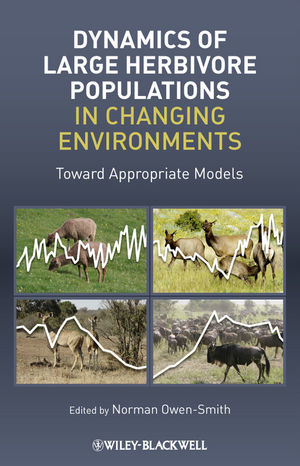Dynamics of Large Herbivore Populations in Changing Environments: Towards Appropriate ModelsISBN: 978-1-4051-9894-3
Hardcover
216 pages
February 2010, Wiley-Blackwell
 Other Available Formats: Paperback
|
||||||
Preface
1 Definitive case studies
Norman Owen-Smith and Jason P. Marshal
1.1 Red deer on Rum
1.2 Soay sheep on Hirta
1.3 Roe deer in France
1.4 Bighorn sheep in Alberta
1.5 Kudu in Kruger
1.6 Wildebeest in Serengeti
1.7 Moose on Isle Royale
1.8 Elk in North Yellowstone
1.9 Overview
Acknowledgments
References
2 The suite of population models
Norman Owen-Smith
2.1 Models of density dependence
2.2 Autoregressive time-series models
2.3 Age- or stage-structured models
2.4 Trophic interaction models
2.5 Physiological or metaphysiological models
2.6 Models accommodating spatial structure
2.7 Individual-based models
2.8 Overview
Acknowledgments
References
3 Climatic influences: temperate–tropical contrasts
Norman Owen-Smith
3.1 Temperate environments
3.2 Tropical and subtropical environments
3.3 Effects of predation and hunting
3.4 Overall assessment
Acknowledgments
References
4 Demographic processes: lessons from long-term, individual-based studies
Jean-Michel Gaillard, Tim Coulson and Marco Festa-Bianchet
4.1 Life history of large herbivores: a brief review
4.2 Differential contributions of demographic parameters to population growth
4.3 Climatic variation, density-dependence,andindividual variability
4.4 Conclusions:howcanfutureanalysesof largeherbivoredemography deal with complex demographic processes?
Acknowledgments
References
5 Irruptive dynamics and vegetation interactions
John E. Gross, Iain J. Gordon and Norman Owen-Smith
5.1 Models of herbivore–vegetation interactions
5.2 Examples of irruptive dynamics
5.3 Effects of irruptions on vegetation
5.4 Changing perspectives
5.5 Synthesis
5.6 Implications for conservation and management
Acknowledgments
References
6 How does landscape heterogeneity shape dynamics of large herbivore populations?
N. Thompson Hobbs and Iain J. Gordon
6.1 What is spatial heterogeneity?
6.2 How does spatial heterogeneity influence ungulate population dynamics?
6.3 Mechanisms explaining the influence of spatial heterogeneity on population dynamics
6.4 Influences from high-quality resources
6.5 Influences from buffer resources
6.6 Global change and access to heterogeneity by large herbivores
6.7 Conclusions: the importance of spatial context for population dynamics
Acknowledgments
References
7 Towards an ecology of population dynamics
Norman Owen-Smith
7.1 Phenomenological descriptors
7.2 Time series elaborations
7.3 Environmental structure
7.4 Population structure
7.5 Adaptive responses and environmental contexts
7.6 Summary and conclusions
Acknowledgments
References
Index



